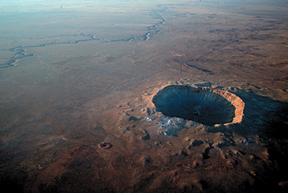 Since Meteor
Crater in Arizona was first discovered and recognized as an impact crater in
the early 20th century, scientists have puzzled over why they could not find
much melted rock at the site. At most impact locales, such as the Chicxulub
crater in Mexico, a distinct layer of melted rocks indicates heat generated
from a high-velocity impact. New findings, however, suggest that rather than
one large meteorite striking the ground at a high velocity, a lower velocity,
pancake-shaped swarm of meteorite pieces — formed from the explosion a
larger meteorite — likely carved out Meteor Crater.
Since Meteor
Crater in Arizona was first discovered and recognized as an impact crater in
the early 20th century, scientists have puzzled over why they could not find
much melted rock at the site. At most impact locales, such as the Chicxulub
crater in Mexico, a distinct layer of melted rocks indicates heat generated
from a high-velocity impact. New findings, however, suggest that rather than
one large meteorite striking the ground at a high velocity, a lower velocity,
pancake-shaped swarm of meteorite pieces — formed from the explosion a
larger meteorite — likely carved out Meteor Crater. Scientists now say that Arizona’s Meteor Crater may have been formed by a swarm of meteorite pieces rather than one large meteorite, which may help to explain why the crater’s geology differs from that of other impact sites. Image Peter L. Kresan, copyright 2005.
The idea of a swarm of meteorites forming the crater had been floated by other researchers in the past, says Bevan French of the Smithsonian Institution in Washington, D.C. But their ideas “never went far enough” to answer the questions, he says. In the new study, published in the March 10 Nature, Jay Melosh and Gareth Collins “bridge the modeling and geologic work to find the answer,” French says.
Last summer, Melosh, of the Lunar and Planetary Laboratory at the University of Arizona in Tucson, and Collins, of Imperial College in London, were “playing with” their public-friendly Web site model of what happens when extraterrestrial objects hit Earth, when they decided to plug in the information they thought they knew about Meteor Crater. “Our results showed that Earth’s atmosphere drastically affected the meteorite. At first we thought it had to be a mistake, but after several recalibrations of the model, we found it was right.”
About 55,000 years ago, a 40-meter diameter iron meteorite streaked toward present-day Arizona on a collision course. According to Melosh and Collins’ model, at about 14 kilometers above Earth, the atmospheric pressure caused the meteor to shatter into pieces, which spread out to about 100 meters in diameter. The cluster of meteorite pieces spread slowly, “limited by the low lateral acceleration of the massive iron fragments,” Melosh says. “Aerodynamic drag forces continued to urge the pieces apart while slowing the cluster’s overall velocity.” By the time it reached 5 kilometers above land, the swarm was at least 200 meters across. When the swarm struck land, it had lost 80 percent of its energy and was probably about 300 meters wide, Melosh says.
According to the models, the surface-impact velocity was probably about 12 kilometers per second — far less than the 15 to 20 kilometers per second widely assumed, he says. Nonetheless, the impact set off the equivalent energy of a 2.5-megaton blast of TNT, and left behind a crater that is 1.2 kilometers wide and 174 meters deep.
This explanation makes sense, French says, and is consistent with an absence of large amounts of melt in the crater. An important thought that comes out of this research though, he says, is that an object this small could cause so much damage. Thus, it is important to model other potential impacts with small projectiles to see what would happen in populated areas.

